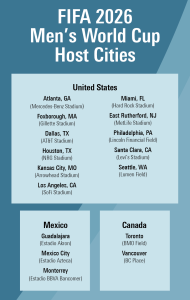 Although the 2022 Men’s FIFA World Cup concluded less than six weeks ago, plans are already being laid for the next iteration of the tournament, which will take place in cities across North America. The United States, Canada and Mexico won their joint bid to host the 2026 Men’s World Cup, which is returning to North America for the first time since the U.S. hosted the tournament in 1994. In June of 2022, FIFA—the international governing body for the sport of soccer—announced the 16 cities which will play host to the tournament.
Although the 2022 Men’s FIFA World Cup concluded less than six weeks ago, plans are already being laid for the next iteration of the tournament, which will take place in cities across North America. The United States, Canada and Mexico won their joint bid to host the 2026 Men’s World Cup, which is returning to North America for the first time since the U.S. hosted the tournament in 1994. In June of 2022, FIFA—the international governing body for the sport of soccer—announced the 16 cities which will play host to the tournament.
The tournament will result in a surge in tourism leading up to and during the tournament, with hundreds of thousands of visitors from all over the world enjoying the games and the related amenities and festivities offered in the host cities. The 2026 World Cup will be the first version of the tournament to include 48 nations, the largest field ever, meaning an unprecedented number of fans, from a greater diversity of places than ever, will have reason to journey to (and around) the U.S. and its two nearest neighbors. And because the tournament field is bigger, more matches will be played than in past tournaments—each stadium could host as many as five matches, depending on the final format of the tournament (which has not yet been decided). With droves of fans traveling into and out of each city for each game, the experience for the host cities will be not unlike hosting a Super Bowl (or five).
This influx of visitors presents a golden opportunity for the host cities to reintroduce themselves on the world stage, and for both public and private entities to make investments in the tourism, hospitality, real estate and construction, and transportation sectors in and around those cities. Some of these investments will be to the event venues themselves. For example, NRG Stadium in Houston is anticipated to require approximately $10 million in renovations to prepare it for hosting World Cup matches. But many opportunities will also exist in the areas around the venues. Host cities (and potentially other cities) will likely have “fan zones” where fans can gather, eat, drink, and watch public broadcasts of games. Operators of local restaurants and hotels will likely renovate or expand their facilities to accommodate bigger crowds and fetch higher rates from new patrons. The owner of a vacant hotel tower near Arrowhead Stadium in Kansas City, one of the host stadiums, is contemplating renovating the building and converting it into a mixed-use residential tower, or an athletic training facility for aspiring athletes. In the San Francisco Bay Area, efforts are already underway to entitle and build a 9.2 million square foot mixed-use development adjacent to Levi’s Stadium, another of the host venues, with plans to ultimately include 1,600 residential units, 500,000 square feet of retail space, 700 hotel rooms, and 102 acres of parks and open space. These host cities would be wise to capitalize on this opportunity and use the World Cup (and the inflow of capital investment and global visitors) to reenergize portions of their cities that have otherwise been slow to recover. Creating new mixed-use projects that can act as hubs for fan activity during the tournament and then easily be converted into hubs of revitalized communities in major cities is a recipe that should be appealing to any potential investor. As 2026 creeps closer, similar projects are certain to get underway in all eleven U.S. host cities.
2026 also represents an important light at the end of the tunnel for the U.S. economy and for many of its industries, which have been heavily disrupted by the COVID-19 pandemic, the resulting acceleration of remote and hybrid work arrangements, rising inflation, and ongoing uncertainty in financial markets. It is impossible to know what will happen with these economic indicators over the coming years, but in any event, the World Cup is likely to be an economic turbo charger for the various host cities. According to one early estimate, the aggregate economic impact of hosting the 2026 World Cup in North America could reach as much as $5 billion, including the support of roughly 40,000 jobs, which is why 22 cities put significant resources behind their bids to win one of the 16 coveted hosting slots. The majority of the economic impact will be centered in and around the host cities, but effects will be felt throughout the country (and the world) as firms in advertising, broadcasting, apparel, and recreation capitalize on the approaching tournament.
The 2026 World Cup may feel far away, but it is not too soon to begin planning for its arrival to North America. The world’s game is coming back to the United States, and with it a surge of investment, tourism, and economic activity that should not be ignored.
RELATED ARTICLES
The Increasing Popularity of Women’s Soccer Heralds a Surge in Investment Opportunities
 Gravel2Gavel Construction & Real Estate Law Blog
Gravel2Gavel Construction & Real Estate Law Blog



